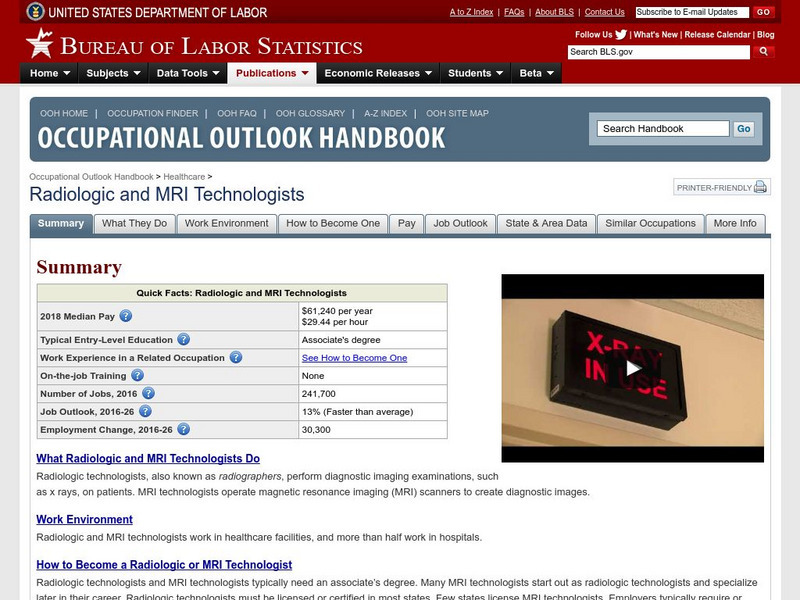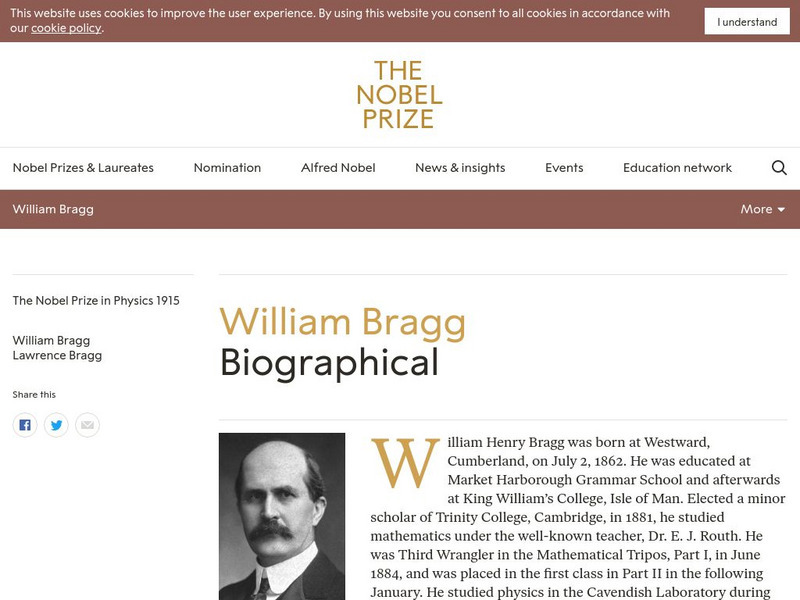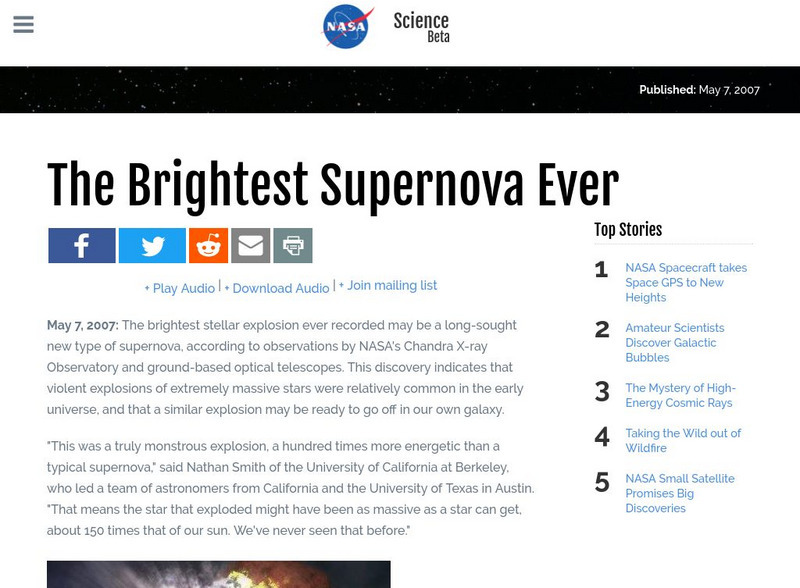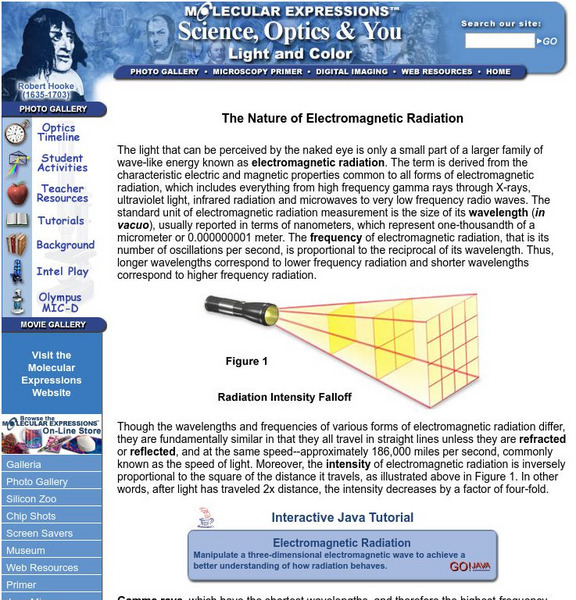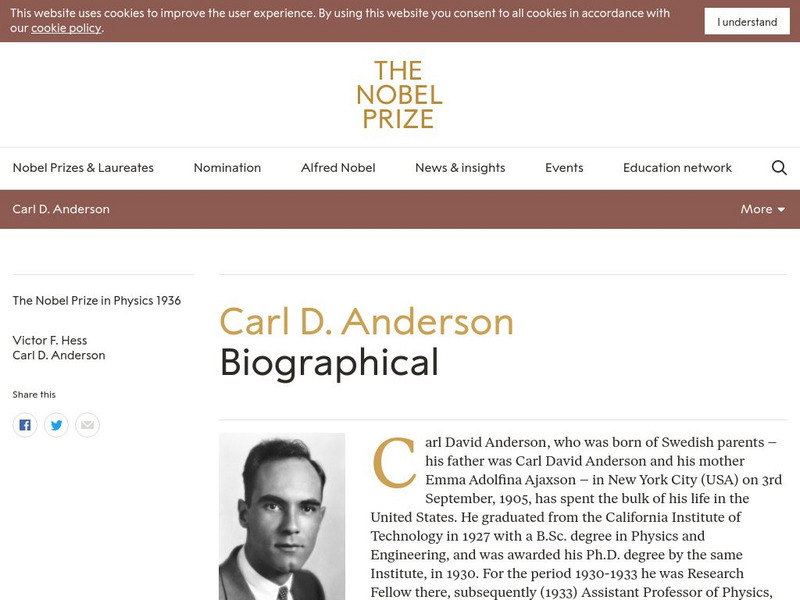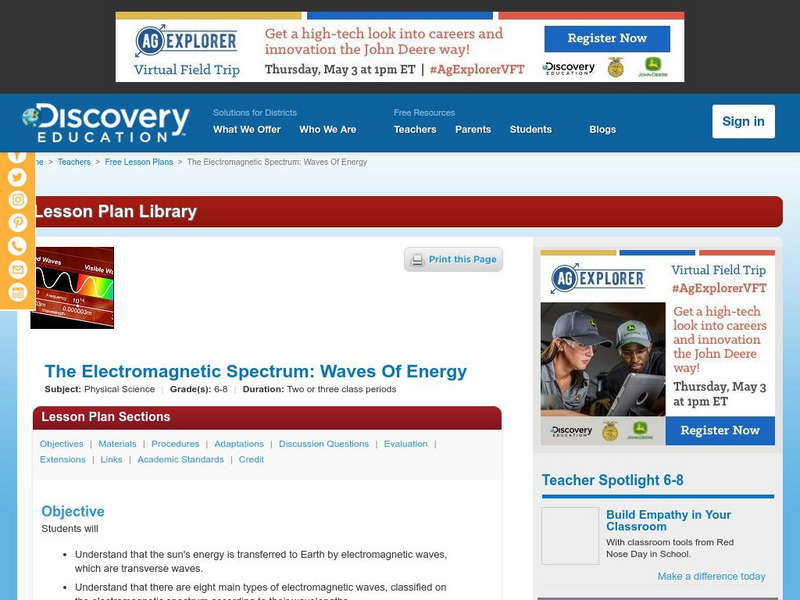US Department of Labor
Bureau of Labor Statistics: Radiologic Technologists
A very informative site describing the profession of radiologic technologist/technician. Contains sections on nature of the work, working conditions, employment opportunities, qualifications, job outlook, and earnings.
University of Colorado
University of Colorado: Physics 2000: Electromagnetic Waves
Using a student-teacher dialogue format, this page discusses the nature of light as an electromagnetic wave and the electromagnetic spectrum.
Lawrence Berkeley National Laboratory
Berkeley Lab: Micro Worlds Project: Advanced Light Source
A discussion of the Advanced Light Source (ALS) facility and its use in material analysis and medicine.
Nobel Media AB
The Nobel Prize: William Henry Bragg Biographical
The Nobel Foundation provides a biography of Bragg. This site focuses primarily on his activities and accomplishments as a scientist.
NASA
Nasa: Imagine the Universe: Pulsars
Resource explores what a pulsar is, as well as what is currently known about this phenomenon. Content includes a focus on x-ray observations of pulsars, and gamma-ray pulsars.
Nobel Media AB
The Nobel Prize: The Nobel Prize in Physics 1901: William Conrad Rontgen
In 1901, Wilhelm Conrad Rontgen won the Nobel Prize for Physics because of his work with the x-ray. The site includes a picture of Rontgen along with biographical information, his Nobel lecture, and other resources, such as illustrated...
Lawrence Berkeley National Laboratory
Berkeley Lab: Did You Ever Wonder? The Crystal Robot
Students examine x-ray crystallography. The resource explores the structure of the proteins specified by tens of thousands of newly sequenced genes. Additional resources are included.
Cosmo Learning
Cosmo Learning: Applied Science and Technology 210: Electrical Engineering
A collection of video lectures from a course that explores the application of electrical engineering topics. Webpage includes twenty-eight lectures from a professor at the University of California, Berkeley. Lectures vary in length and...
National High Magnetic Field Laboratory
Magnet Academy: Peter Debye
Peter Debye carried out pioneering studies of molecular dipole moments, formulated theories of magnetic cooling and of electrolytic dissociation, and developed an X-ray diffraction technique for use with powdered, rather than...
NASA
Nasa Science: The Brightest Supernova Ever Seen
Article explores the supernova of a star that is possibly "150 times more massive than our Sun." The primary observations of the explosion were accomplished through the Chandra X-ray Observatory. (May 7, 2007)
NASA
Nasa: Imagine the Universe: X Ray Binary Stars
Site provides a brief introduction to binary stars. Additional resources for students and teachers on this topic are offered as well as related topics.
National Inventors Hall of Fame
National Inventors Hall of Fame: Robert Ledley: Diagnostic X Ray System/cat Scan
Read about the inventor of the CAT Scan, Robert S. Ledley. This site includes a brief bio and information on the invention's impact on the medical world and patients.
University of Pittsburgh
University of Pittsburgh: X Ray Crystallography Lab
This is the University of Pittsburgh crystallography departments home page. The site has links to programs, facilities, research, etc.
BBC
Bbc: Gcse Bitesize: Radiation Treatment
X-rays, gamma rays and beta particles are all used in medicine to treat internal organs. X-rays are produced by firing electrons at a metal target and gamma rays are emitted by the nucleus of radioactive atoms. Gamma rays are used to...
Florida State University
Florida State University: Nature of Electromagnetic Radiation
This site from The Florida State University provides an informational page on electromagnetic radiation discusses the characteristics and properties of its many forms including X-rays, gamma rays, ultraviolet radiation, infrared...
Famous Scientists
Famous Scientists: Wilhelm Rontgen
A short biography about the scientist who produced and detected electromagnetic radiation in a wavelength range known as X-rays or Rontgen rays, which earned him the first Nobel Prize in Physics in 1901.
National High Magnetic Field Laboratory
Magnet Academy: Timeline of Electricity and Magnetism: 1890 1899
Scientists discover and probe x-rays and radioactivity, while inventors compete to build the first radio.
Nobel Media AB
The Nobel Prize: Carl D. Anderson Biographical
This site provides a brief article from The Nobel Foundation on the American Physicist, Carl David Anderson. The article overviews his education and involvement in radiation research and cosmic-ray studies, through which he discovered...
Discovery Education
Discovery Education: The Em Spectrum: Waves of Energy
Students are introduced to the electromagnetic spectrum through this group research activity. Each group investigates a different wavelength range within the em spectrum and reports back to class. Discussion ideas also included.
University of California
U.c. Berkeley: Spectra From Space
View the entire spectrum of electromagnetic radiation and get information on telescopes especially designed to view different wavelengths of the spectrum.
Nobel Media AB
The Nobel Prize: Wilhelm Conrad Rontgen Biographical
This biographical note on Wilhelm Conrad Rontgen describes his boyhood, upbringing, education, scientific work and accomplishments. Focuses on his studies of Xrays.
Other
Why Did I Choose to Become a Radiologist?
This is a great site the discusses the role of a radiologist as well as the instruments they use, what conditions they treat, and much more.
Other
Healthy Teeth: Oral Health Education Database: Prevention
Get tips on how to prevent tooth decay. Learn how flouride works, as well as how to floss and brush your teeth. More specific information on dental x-rays and different sealants is also provided.
Other popular searches
- Animal X Rays Preschool
- Animal X Rays
- X Rays Mri Bones
- Preschool Lessons X Rays
- X Rays Art Preschool
- Understanding X Rays
- Bones and X Rays
- X Rays and Scans
- X Rays Preschool
- X Rays Tech
- X Rays Tech Schools
- Radiation and X Rays

